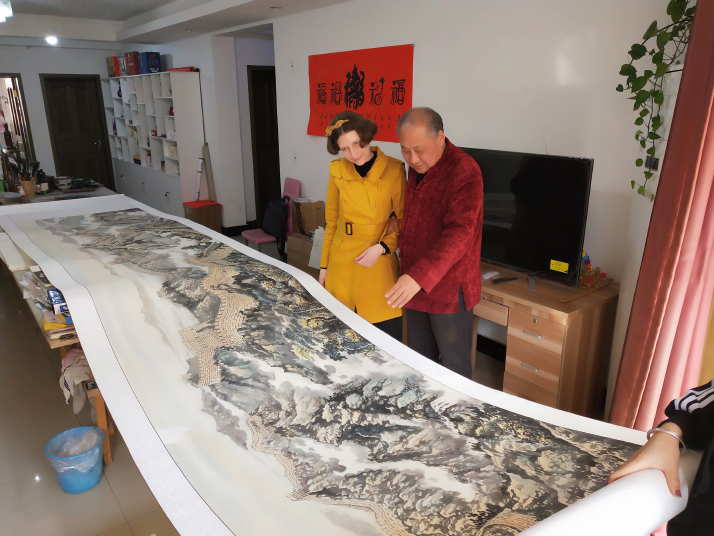| Lifestyle |
| Doing Only One Thing | |
|
|
 Painter Wang Xing (right) shows the author the magnum opus he is working on--a scroll depicting the Great Wall at Badaling (COURTESY PHOTO)
Call me a calligraphy and Chinese painting junkie. While other women spend their money on designer clothes and shoes, I spend mine on a painting with avant-garde plum blossoms, a faux Qi Baishi or a misty Yellow Mountain scene in autumn. So, naturally, when a Chinese calligraphy master invited me to his studio, I was excited. What a treat! My limited exposure to calligraphy up to that point consisted of strolling through the National Art Museum of China exhibits or admiring elderly men "painting" characters on Beijing's sidewalks with large brushes, water and a few flicks of the wrist. Calligraphy master and painter Wang Xing is an internationally renowned prize-winning artist who is involved in many associations promoting calligraphy. His spacious apartment in the outskirts of Beijing doubles as a studio, where he creates calligraphy and also paints. The living room has a long table which features some of the "treasures of the practice": a collection of brushes of varying sizes, the biggest ink pots I have ever seen, paper and newspaper as blotting material, and a pair of paper weights. He told me that in China, calligraphy is sometimes used by certain brands—sort of like a logo—and I was surprised to learn the calligraphy on the "13 Spices Powder" packaging is his creation. A friend commented later that it actually does look like a painting. Indeed, calligraphy and painting are very much related; after all Chinese characters originated from pictographs. As a matter of fact, Chinese paintings will often feature a little flowing calligraphy, cascading down the side like a waterfall with the artist's name and sometimes the year and subject matter, like a running commentary. Of course, the artist's personal seal in red ink is also included. To me, and I assume many other foreigners, calligraphy may be harder to appreciate than Chinese painting because traditional paintings are based on objects, with two major subjects, birds and flowers or landscapes, whereas calligraphy is closer to abstract art. Master Wang invited me to practice calligraphy, but I politely declined. My short-lived forays into the calligraphy world were limited to the Chinese New Year and only produced scribble scrabble, which found me sheepishly throwing my ink-stained monstrosities in the trash! Instead he kindly produced characters for me. We settled on suiyuan (according to fate), such a simple yet weighty expression that supposedly determines so much of what happens in life. He produced the characters with a few masterstrokes of his hand and they were exquisite. Master Wang then showed me his current focus, a magnum opus in progress: a scroll depicting the Great Wall at Badaling, which will be exhibited in the National Museum in Beijing. He has been working on the painting for three years. The seven-meter-long scroll painting was breathtakingly beautiful, with the only trace of human activity being the manmade wall itself. It reminded me of the famous Song Dynasty (960-1279) painting Along the River During the Qingming Festival, except that Master Wang's painting is timeless because there are no humans in it and it is hard to determine what season it is. He told me someone had offered to buy it for an exorbitant amount of money, but he refused to part with the painting as he wanted to donate it to the museum. After the visit to his studio, we crossed the street to visit a country store. The modest store had Master Wang's lofty calligraphy hanging on the walls. It was then that I noticed that Master Wang appeared to have a very healthy constitution. I wondered if it was the calligraphy keeping him so healthy. Like meditation, calligraphy is said to have health benefits such as stress reduction and long life. Whether that is true, one thing is certain, as Master Wang put it, "Only do one thing and do it well—that is the secret to success." The author is an American living in Beijing Copyedited by Rebeca Toledo Comments to yanwei@bjreview.com |
|
||||||||||||||||||||||||||||
|
